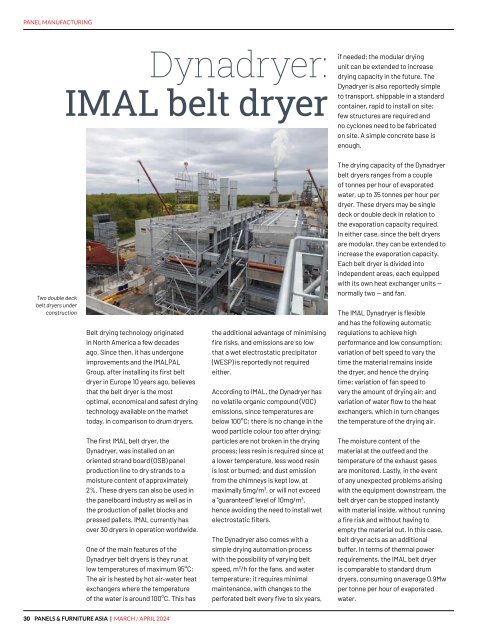Panels & Furniture Asia March/April 2024
Panels & Furniture Asia (PFA) is a leading regional trade magazine dedicated to the woodbased panel, furniture and flooring processing industry. Published bi-monthly since 2000, PFA delivers authentic journalism to cover the latest news, technology, machinery, projects, products and trade events throughout the sector. With a hardcopy and digital readership comprising manufacturers, designers and specifiers, among others, PFA is the platform of choice for connecting brands across the global woodworking landscape.
Panels & Furniture Asia (PFA) is a leading regional trade magazine dedicated to the woodbased panel, furniture and flooring processing industry. Published bi-monthly since 2000, PFA delivers authentic journalism to cover the latest news, technology, machinery, projects, products and trade events throughout the sector. With a hardcopy and digital readership comprising manufacturers, designers and specifiers, among others, PFA is the platform of choice for connecting brands across the global woodworking landscape.
Create successful ePaper yourself
Turn your PDF publications into a flip-book with our unique Google optimized e-Paper software.
PANEL MANUFACTURING<br />
Dynadryer:<br />
IMAL belt dryer<br />
if needed; the modular drying<br />
unit can be extended to increase<br />
drying capacity in the future. The<br />
Dynadryer is also reportedly simple<br />
to transport, shippable in a standard<br />
container, rapid to install on site;<br />
few structures are required and<br />
no cyclones need to be fabricated<br />
on site. A simple concrete base is<br />
enough.<br />
Two double deck<br />
belt dryers under<br />
construction<br />
Belt drying technology originated<br />
in North America a few decades<br />
ago. Since then, it has undergone<br />
improvements and the IMALPAL<br />
Group, after installing its first belt<br />
dryer in Europe 10 years ago, believes<br />
that the belt dryer is the most<br />
optimal, economical and safest drying<br />
technology available on the market<br />
today, in comparison to drum dryers.<br />
The first IMAL belt dryer, the<br />
Dynadryer, was installed on an<br />
oriented strand board (OSB) panel<br />
production line to dry strands to a<br />
moisture content of approximately<br />
2%. These dryers can also be used in<br />
the panelboard industry as well as in<br />
the production of pallet blocks and<br />
pressed pallets. IMAL currently has<br />
over 30 dryers in operation worldwide.<br />
One of the main features of the<br />
Dynadryer belt dryers is they run at<br />
low temperatures of maximum 95°C:<br />
The air is heated by hot air-water heat<br />
exchangers where the temperature<br />
of the water is around 100°C. This has<br />
the additional advantage of minimising<br />
fire risks, and emissions are so low<br />
that a wet electrostatic precipitator<br />
(WESP) is reportedly not required<br />
either.<br />
According to IMAL, the Dynadryer has<br />
no volatile organic compound (VOC)<br />
emissions, since temperatures are<br />
below 100°C; there is no change in the<br />
wood particle colour too after drying;<br />
particles are not broken in the drying<br />
process; less resin is required since at<br />
a lower temperature, less wood resin<br />
is lost or burned; and dust emission<br />
from the chimneys is kept low, at<br />
maximally 5mg/m 3 , or will not exceed<br />
a “guaranteed” level of 10mg/m 3 ,<br />
hence avoiding the need to install wet<br />
electrostatic filters.<br />
The Dynadryer also comes with a<br />
simple drying automation process<br />
with the possibility of varying belt<br />
speed, m 3 /h for the fans, and water<br />
temperature; it requires minimal<br />
maintenance, with changes to the<br />
perforated belt every five to six years,<br />
The drying capacity of the Dynadryer<br />
belt dryers ranges from a couple<br />
of tonnes per hour of evaporated<br />
water, up to 35 tonnes per hour per<br />
dryer. These dryers may be single<br />
deck or double deck in relation to<br />
the evaporation capacity required.<br />
In either case, since the belt dryers<br />
are modular, they can be extended to<br />
increase the evaporation capacity.<br />
Each belt dryer is divided into<br />
independent areas, each equipped<br />
with its own heat exchanger units —<br />
normally two — and fan.<br />
The IMAL Dynadryer is flexible<br />
and has the following automatic<br />
regulations to achieve high<br />
performance and low consumption:<br />
variation of belt speed to vary the<br />
time the material remains inside<br />
the dryer, and hence the drying<br />
time; variation of fan speed to<br />
vary the amount of drying air; and<br />
variation of water flow to the heat<br />
exchangers, which in turn changes<br />
the temperature of the drying air.<br />
The moisture content of the<br />
material at the outfeed and the<br />
temperature of the exhaust gases<br />
are monitored. Lastly, in the event<br />
of any unexpected problems arising<br />
with the equipment downstream, the<br />
belt dryer can be stopped instantly<br />
with material inside, without running<br />
a fire risk and without having to<br />
empty the material out. In this case,<br />
belt dryer acts as an additional<br />
buffer. In terms of thermal power<br />
requirements, the IMAL belt dryer<br />
is comparable to standard drum<br />
dryers, consuming on average 0.9Mw<br />
per tonne per hour of evaporated<br />
water.<br />
30 PANELS & FURNITURE ASIA | MARCH / APRIL <strong>2024</strong>

















